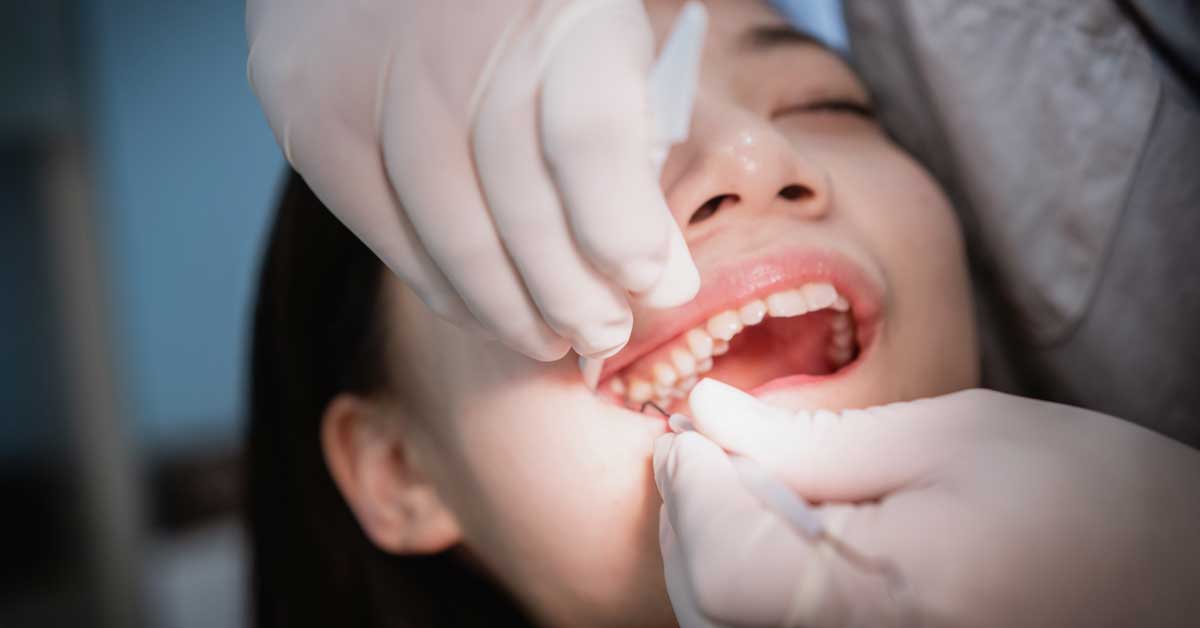How to Stop Receding Gums?
Are you tired of staring at your reflection in the mirror, obsessing over your receding gums? Perhaps you shy away from smiling, embarrassed by the unsightly gaps between your teeth.
Don’t worry, you’re not alone. Receding gums is a common dental problem that not only affects your appearance but can also lead to tooth sensitivity, tooth loss, and gum disease if left untreated. In this article, we have discussed how to stop receding gums so read on to find out.
What Are Receding Gums and What Causes Those?
Receding gums is a common dental issue you might face, referring to the gradual pulling back of your gum tissue from around your teeth. This exposes more of your tooth or your tooth’s root, which can lead to sensitivity and even affect the aesthetics of your smile. But what causes your gums to recede? Quite a few factors contribute to this condition.
Several factors can cause your gums to recede, including:
· Aggressive tooth brushing: If you brush your teeth too hard or the wrong way, it can wear down your enamel and cause your gums to recede.
· Poor dental hygiene: Inadequate brushing, flossing, and rinsing with antibacterial mouthwash makes it easy for plaque to turn into tartar.
· Periodontal diseases: These are bacterial gum infections that destroy gum tissue and the supporting bone that holds your teeth in place.
· Genetics: Some people may be more susceptible to gum disease. If your parents had gum recession, you might be at higher risk too.
· Tobacco products: Smokers and those who use tobacco products are more likely to have sticky plaque on their teeth that is hard to remove and can cause gum recession.
· Grinding and clenching your teeth: Clenching or grinding your teeth can put too much force on the teeth, causing gums to recede.
· Hormonal changes: Fluctuations in female hormone levels during a woman’s lifetime, such as puberty, pregnancy, and menopause, can make gums more sensitive and more vulnerable to gum recession.
How to Stop Receding Gums?
To stop receding gums, maintain rigorous oral hygiene by brushing gently with a soft-bristled toothbrush, flossing daily, and using an antiseptic mouthwash. Regular dental check-ups and cleanings are crucial.
Quit smoking, manage stress, and consider a balanced diet to support gum health. In advanced cases, treatments like scaling and root planing, gum grafts, or laser therapy may be recommended by your dentist to repair damage and prevent further recession.
Proper Flossing
Proper flossing is one of the easy ways how you can prevent receding gums. By removing plaque and food particles between your teeth and below the gumline, flossing helps to fight the bacteria that lead to gum disease.
When you don’t floss regularly, plaque builds up and can harden into tartar, which can contribute to gum recession. To floss correctly, gently slide the floss up and down and curve it around the base of each tooth, making sure you go beneath the gumline. Don’t force the floss, as this can damage your gums.
Oil Pulling
Oil pulling is an ancient practice that can be beneficial if you’re experiencing receding gums. This simple technique involves swishing a tablespoon of oil, typically coconut, sesame, or sunflower oil, in your mouth for about 10-20 minutes each day. As you swish, the oil traps bacteria and toxins that can contribute to gum recession and oral diseases.
Over time, oil pulling may help reduce inflammation and promote healing in the gums, making them stronger and healthier. To get the best results, be sure to do your oil pulling in the morning on an empty stomach and follow it with your regular dental hygiene routine.
Herbal Extracts
Various herbal extracts have proven to be effective in managing plaque and other oral health issues. Studies have suggested that essential oils such as peppermint, thyme, and tea tree possess anti-septic properties. Moreover, another study has suggested that mouthwash containing extracts of clove, basil, and tea tree oil also possesses anti-plaque and anti-gingivitis properties.
Stop any Tobacco Products
Quitting tobacco products plays a crucial role in the treatment and healing of receding gums. When you stop using tobacco, you essentially halt its negative impact on your oral health. Tobacco restricts blood flow to your gums, which is vital for maintaining healthy tissue and supporting the natural repair processes.
By eliminating tobacco, you are allowing your blood vessels to recover and improve circulation, which can in turn encourage the regeneration of your gum tissue.
Furthermore, studies have directly linked tobacco to the build-up of plaque on teeth, which is a significant cause of gum recession. When you cut out cigarettes, chewing tobacco, or other related products, you reduce the accumulation of plaque and the likelihood of developing tartar, thereby decreasing your chances of gum disease. This not only helps in stopping further recession but also supports your gums as they heal and regenerate.
Regular Appointments with Your Dentist
Regular appointments with your dentist are essential for catching and treating receding gums early. Your dentist can identify the signs of gum recession and recommend appropriate interventions.
Professional cleaning is often the first line of action, removing tartar and plaque build-up that can contribute to gum disease. They might also guide you through proper brushing and flossing techniques to prevent further harm to your gums.
In some cases, your dentist may suggest a treatment called scaling and root planing, which cleans deeply below the gumline.
What are some surgical Procedures to Treat Receding Gums?
If nothing has worked so far, surgical intervention may be needed. One common technique is open flap scaling and root planning, where your periodontist will peel back the gums to remove plaque and tartar buildup from the roots, promoting healing in the area. Another procedure is regeneration, which involves folding back the gum tissue to remove bacteria and then placing a regenerative material such as a membrane, graft tissue, or tissue-stimulating protein to encourage your body to naturally regenerate bone and gum tissue in the affected area.
Lastly, a soft tissue graft might be recommended where tissue from another part of your mouth is grafted onto the affected area to cover exposed roots and help rebuild gum tissue. These treatments can greatly reduce further gum recession, and bone loss and protect your teeth for a healthier smile.
Conclusion
Tackling the issue of receding gums requires a multi-faceted approach that encompasses both preventive measures and, if necessary, professional treatments. By understanding the causes of gum recession, you can take proactive steps to maintain good oral hygiene, adopt healthier lifestyle choices, and seek timely dental advice.
Regular brushing with a soft-bristled toothbrush, proper flossing, and the use of antiseptic mouthwash form the cornerstone of preventing gum recession. Additionally, quitting tobacco products, managing stress, and maintaining a balanced diet are crucial for gum health.
For those already experiencing receding gums, professional dental treatments such as scaling and root planing, gum grafts, or laser therapy offer effective solutions to halt progression and encourage healing. Remember, early detection and intervention are key.
Regular dental check-ups allow for the early identification of potential issues and the implementation of corrective measures before they escalate. By following these guidelines, not only can you stop receding gums in their tracks, but you can also enjoy a healthier, more confident smile.
Frequently Asked Questions
Early signs of receding gums include increased tooth sensitivity, especially near the gum line, visible tooth roots, longer-looking teeth, and red, swollen, or bleeding gums upon brushing or flossing. Early intervention can help prevent further gum recession.
Receding gums cannot grow back naturally. However, proper oral hygiene and treatments like scaling and root planing can halt further recession and protect exposed roots. In severe cases, surgical options like gum grafts may be recommended to cover exposed roots and restore gum health.
To prevent gum recession, practice good oral hygiene: brush gently with a soft-bristled toothbrush twice daily, floss regularly, and use an antiseptic mouthwash. Avoid aggressive brushing and tobacco use. Regular dental check-ups and cleanings are crucial for early detection and management of gum disease, a leading cause of gum recession.
You should see a dentist about receding gums if you notice increased tooth sensitivity, visible tooth roots, or changes in your gum line. Early signs like red, swollen, or bleeding gums upon brushing or flossing also warrant a dental visit. Prompt attention can prevent further damage and identify underlying causes, such as gum disease, that require treatment.
Common causes of receding gums include gum disease (gingivitis and periodontitis), aggressive brushing or use of hard-bristled toothbrushes, poor oral hygiene, tobacco use, hormonal changes (especially in women), genetics, and clenching or grinding teeth (bruxism). Regular dental check-ups can help identify and address these factors early to prevent further gum recession.
Cosmetic and General Dentistry In Miami, FL
Take the first step towards the smile of your dreams by booking a consultation with our experts in cosmetic and general dentistry.



